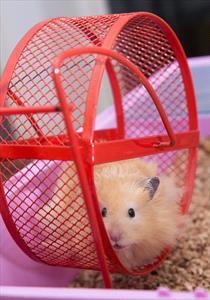Mountains at twilight

Photo courtesy of Depositphotos
You finally manage to fall sleep at 4:15 a.m., just in time for your kid's hamster Fuzzball to start his daily training for a marathon on his exercise wheel, your sister's chinchilla to scuttle about her cage, and your bunny to gnaw on a fairly thick twig / small branch / wood thingamajig.* You have learned to sleep through some of this early morning activity and again you fall back to sleep at 4:40, just in time for your cat to whap you in the face for breakfast at 4:43 a.m. despite repeated requests to wait until 7 a.m. (Someone needs to teach cats how to tell time; I end up feeling like Little Miss Crankypants when that happens.)
Do your fellow four-legged house mates prefer you with bags and circles under your eyes? If not, then why do they wake you up when you’re sleeping? “Because they can” is not an actual answer, no matter how many thousands of times I’ve used it as one.
It’s because they’re crepuscular. Not fat – that’s corpulent, although watching hamsters stuff food in their mouths is akin to seeing how many tennis balls Labrador retrievers can hold in their mouths. Crepuscualr is the Latin word for twilight: crepusculum. It means some animals are more likely to be awake and active at dawn or dusk than during the day or night.
Crepuscular animals do not stay out after nightfall; they’re not big on hanging out for a beer after work for Fred’s birthday. After dinner, their activity level gears down as they slumber on the couch watching Lassie reruns, and they remain there, for the most part, ‘til the first peeps of sunlight surface. (Vampire disaster time!)
Nor are crepuscular types diurnal, meaning active during the daytime, like homo sapiens, ostriches and bearded dragons. Crepusculars are also not active from dawn all the way through to dusk; those are nocturnal animals, which include racoons; vampires, who, despite the Twilight series, cannot go to high school in overcast Seattle during the day; and vampire bats, which are so ugly they cannot in any way, shape or form be referred to as “so ugly they're cute."
Of course, it’s not a precisely timed event. Your hamster is not going to see tendrils of sunlight come up and suddenly careen off his wheel in deep REM sleep. Crepusculars may go walkabout on a night bright with moonlight or on a day that is overcast. As you know, domestic cats spend their day sleeping, but they wake up when something interesting happens: food comes out, family members come home, visitors appear, or they need to tell the dog to stop barking.
More animals than we realize are crepuscular. You know and enjoy some of them in the wild, such as the delightful firefly and deer in the pasture. Other crepuscular types include jaguars, ocelots, bobcats, red pandas, bears, moose, capybaras (who take their role as world’s largest rodent quite seriously), skunks, possums, wallabies, spotted hyenas, some bats, and the radar-eared African wild dogs, to name a few. Some birds, such as the common nighthawk are crepuscular but the barn owl really is a night owl; they tend to get more homework done than crepuscular owls.
Hamster on red wheel

Photo courtesy of Depositphotos
As it turns out, many pets are crepuscular. Knowing which ones are on this list will help you pick suitable pets for your household. So, which ones are likely to sleep most of the day and night?
- Cats, although they certainly are not chosen for or despite their crepuscular nature;
they’re chosen because they are hilarious, stunningly beautiful, and are great cuddlers.
- Hamsters (surprise!)
- Mice
- Rats
- Chinchillas**
- Rabbits
- Ferrets
- Guinea pigs
- Some species of snakes, lizards and insects.
Why are these guys crepuscular? It has to do with breakfast and dinner times, specifically the meal times of those who eat them. For example, wild Syrian hamsters have numerous predators who would like to take them out as dinner, so the hamsters evolved to become active when their predators are more likely to be inactive. Rabbits, sadly, are practically the bottom of the food chain and can only act uppity towards dandelions. A nifty technical phrase for it, should you get this in a trivia quiz, is “antipredator adaptations.”
What does this mean when you live with a crepuscular pet?
For starters, don’t wake them up when they are sleeping. Let sleeping hamsters lie, because they will be crankypants if rudely awoken at 2 p.m. for no reason other than “I wanted to say hi.” They might be okay with a midnight run for food, though. You never know. Once they wake up, give them time to wake up fully on their own. No nudging, no whispering, "Are you awake, Fuzzball? Are you awake now? Now? Fuzzball?" You may get bitten for your efforts, and rightfully so, as that is inconsiderate in Crespy Land. You don’t want someone picking up your mattress and sliding it off the bed when you’re half asleep, right? My dad used to do that when I was a teenager. If this has not happened to you, you can guess that you end up being really crankypants.
In other words, respect your animal’s sleep patterns even knowing they will not return the favor. Your pets are a different species than you are, and they not only require different food and medicine but also have their preferred times to sleep – as do you. Crepusculars have to live on their own terms, not ours, even in our homes.
*Thingamajig is a real word – my dad said it all the time. Where’s a dictionary that includes a section on “Dad’s Technical Terms”? Oh wait, maybe it’s thingamabob, do-hickey, or the ever popular gizmo.
**For trivia games/quiz nights, remember that while humans only have one hair per hair follicle, chinchillas have around 60 hairs per follicle. Between that tidbit and the “antipredator adaption” concept, one day you’re gonna crush it!